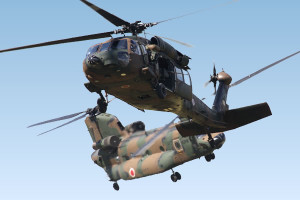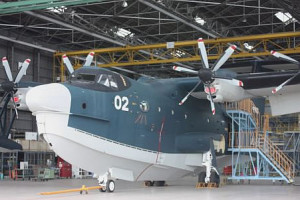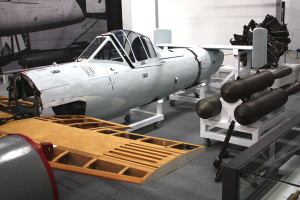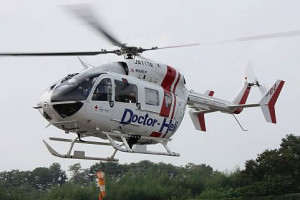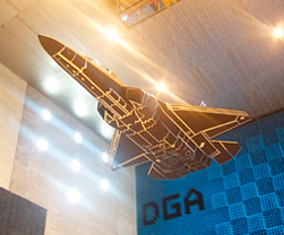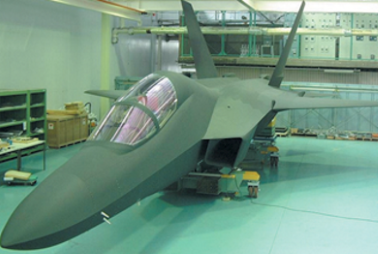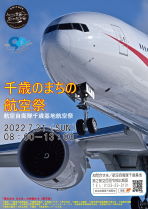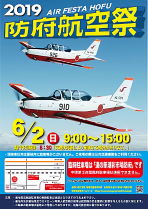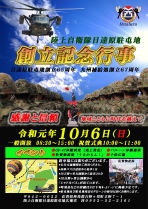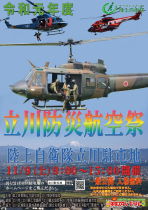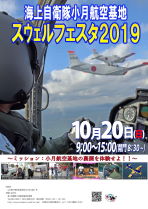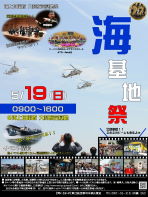Air Development & Test Wing
|
Air Development & Test Wing |
Formed | As Air Proving Group: Dec. 1, 1955 (T-34A at Hamamatsu) As Air Proving Wing: April 11, 1974 As Air Development & Test Wing: March 1989 |
| Current Base | Gifu (Air Development & Test Command, various aircraft) |
Starting out in November 1955 as an operational test and evaluation unit offshoot of a research unit within the 1st Flying Training School at Hamamatsu, the Air Proving Group boasted 28 personnel and two T-34As at the time of its formation the following month. From assembly to delivery, the Group handled the Vampire that was its first jet, imported to assess the advantages and disadvantages of its side-by-side seating configuration, and had graduated to the utilization of F-86Fs by the following year. Examples of the T-6G and T-33A as well as a solitary T-28 were supplied, but as space was being taken up by the fighter units that were then in the process of forming, a move was made and the unit’s long residency at Gifu commenced on March 25, 1957.
During the period of F-86F operations, the aircraft assigned to the APG were regularly changed. The flight test programmes conducted on the type included the Japanese-designed XAAM-1 air-to-air missile and tactical air navigation (TACAN) equipment. Whereas the F-86F was to remain in APG service until late in 1971, a small number of F-86Ds were only operated for a short time.
From January 1958, the APG took charge of the first flight of the T1F2 trainer (later the Fuji T-1), Japan’s first indigenously produced postwar jet aircraft, and then went on to conduct the test flight and acceptance testing programmes. Flight testing of an F-104J Starfighter commenced in 1962, but as Gifu possessed no expertise in the operation of the type, a detachment was sent to Chitose air base until 1966 to conduct all types of testing from there. Attended by four trainees, the first test pilot course (TPC) was commenced in 1969.
Having been renamed as the Air Proving Wing on April 11, 1974, to reflect its higher status, a succession of JASDF types—among them the F-4EJ, T-2 and C-1—continued to undergo initial and ongoing testing during the course of the 70s. Over the years, some types have undergone extended test programmes, others (such as the C-130H, U-4 and U-125) only brief periods of operational testing prior to service entry.
[ADDITIONAL TEXT IN PREPARATION]
GIFU CAVALCADE BY DECADE
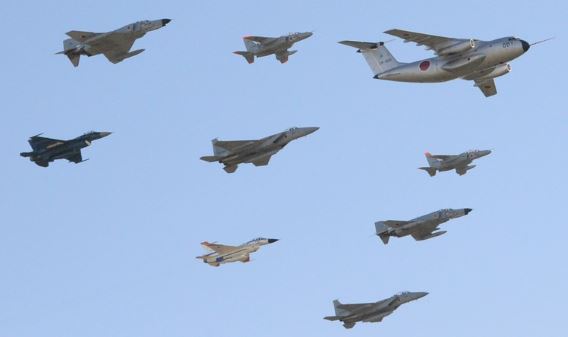 It has become the tradition for a formation flypast of based aircraft to kick off the annual Gifu AB open
It has become the tradition for a formation flypast of based aircraft to kick off the annual Gifu AB open
house event. This photo shows nine of the 10-aircraft delta formation flown to open the
October 2016 event. (Photo: JASDF Gifu AB)
1950s
1956 de Havilland Vampire T.55 63-5571

Built at de Havilland’s Broughton factory in January 1956, this was the Vampire imported into Japan for evaluation in August of that year. Already withdrawn from active operations in January 1960, the aircraft was used for PR/recruitment purposes at SDF exhibitions, which included being parked next to a roller coaster at an event held at Tokyo’s Futako-Tamagawa Park in March 1963 (link), then passed to the 1st Technical School at Hamamatsu as an instructional airframe. It was then stored and occasionally given a public airing at Hamamatsu from the 1970s before being placed on permanent display at the JASDF Air Park at that base in March 2000.
1958 Fuji T1F2 (T-1A) 85-5801
 (Photo [exact date unknown]: JASDF Gifu AB)
(Photo [exact date unknown]: JASDF Gifu AB)
The first new aircraft to be put through a test programme at Gifu was the T1F2 (later T-1A), which manufacturer Fuji had flown for the first time from its Utsunomiya facility on January 19, 1958.
1960s
1963 Lockheed F-104J Starfighter 36-8536
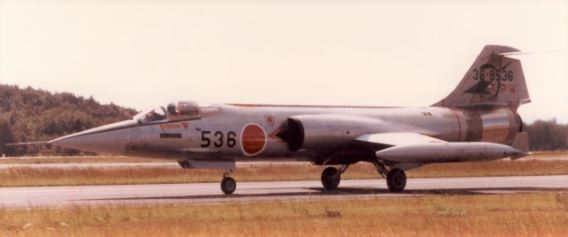 (Photo [exact date unknown]: JASDF Gifu AB)
(Photo [exact date unknown]: JASDF Gifu AB)
Delivered in August 1963, F-104J ’536 spent its entire career with the then Air Proving Group/Wing. Following its withdrawal from use in April 1986, the airframe was acquired at some stage by the Kissa Hikōjō (Airfield Café) in Hamamatsu, Shizuoka Prefecture, which opened in December 1987. The aircraft’s nose section was still present in December 2016.
1970s
1971 McDonnell-Douglas F-4EJ Phantom II 17-8301
 (Photo [exact date unknown]: JASDF Gifu AB)
(Photo [exact date unknown]: JASDF Gifu AB)
Another aircraft that has enjoyed permanent residency at Gifu, the first F-4EJ was one of the pair that arrived in Japan from the McDonnell-Douglas factory in St. Louis, Missouri, in March 1971. (See 2016)
1971 Mitsubishi XT-2 19-5101
 (Photo [date unknown]: JASDF Gifu AB)
(Photo [date unknown]: JASDF Gifu AB)
First flown on July 20, 1971, the first prototype XT-2 was delivered to the then APG in December that same year. Having officially lost the ‘X’ in its designation on August 29, 1973, this T-2 went on to serve another 30 years before being retired early in 2003. On April 14, 2003, a ceremony was held to mark its addition to the aircraft on display at Mitsubishi Heavy Industries Nagoya Aerospace Systems’ Komaki South Plant, where the exhibits from the adjoining museum were being relocated to within MHI’s Oe Plant during the course of 2018.
1972 Kawasaki C-1 28-1001 (originally 18-1001)
 (Photo [date unknown]: JASDF Gifu AB)
(Photo [date unknown]: JASDF Gifu AB)
Having been flown for the first time on November 12, 1970, the XC-1 joined the Gifu test fleet in 1972. (See 2016)
1978 Fuji T-1B 05-5810
 (Photo [Misawa, Oct. 1978]: Akira Watanabe)
(Photo [Misawa, Oct. 1978]: Akira Watanabe)
Delivered to the APG on November 30, 1960, the 10th T-1 built had been modified from T-1A to T-1B standard during manufacture. Seen in the natural metal finish that was standard at the time, this aircraft spanned the three iterations of the JASDF’s test establishment. Its last flight took place on March 2, 2006. (See AD&TW Special Markings/2005)
1978 Fuji T-3 81-5501
 (Photo [date unknown]: JASDF Gifu AB)
(Photo [date unknown]: JASDF Gifu AB)
Today stored at Shizuhama for display purposes, the first T-3 (Fuji KM-2B) made its maiden flight on January 17, 1978, and was passed to the APW later that year.
1980s
1980 McDonnell-Douglas F-15J Eagle 02-8801
 (Photo [date unknown]: JASDF Gifu AB)
(Photo [date unknown]: JASDF Gifu AB)
As the service second only to the U.S. Air Force in terms of the number of F-15s procured, the JASDF has conducted ongoing upgrade and weapons integration testing since the first pair arrived from manufacturer McDonnell-Douglas in 1980. Shown here, the first aircraft had completed its maiden flight on June 4 of that year. (See 2016)
1982 Mitsubishi T-2CCV 29-5103
 (Photo [date unknown]: JASDF Gifu AB)
(Photo [date unknown]: JASDF Gifu AB)
Originally delivered in July 1972, the third prototype XT-2 (29-5103) was passed to the APW in April 1982 for conversion to T-2CCV (Control Configured Vehicle) standard. The fly-by-wire technology flight test programme lasted two years. Finally withdrawn from use on October 31, 2002, the aircraft was placed on loan display at Gifu-Kakamigahara Air and Space Museum in December 2014. (See dedicated page on Gifu-Kakamigahara Air and Space Museum)
1985 F-104J Starfighter 36-8549
 (Photo: Akira Watanabe)
(Photo: Akira Watanabe)
Komatsu, May 19, 1985. This F-104J was delivered to the JASDF in October 1963 and was nearing the end of its service carrer when this photo was taken. Still wearing APW markings, the aircraft’s last home was a narrow enclosure in Sun Green Park in what is now the city of Fukaya, Saitama Prefecture, from where it had been removed from display by 2005.
1985 Kawasaki EC-1 78-1021
 (Photo: Hunini via Wikimedia Commons)
(Photo: Hunini via Wikimedia Commons)
Seen here on a return visit to Gifu in November 2008, the Kawasaki EC-1 was only temporarily assigned to the APW during its initial development. First flown on December 3, 1984, the aircraft was based at Gifu from late 1985 to June 1986, when passed to the then Electronic Warfare Support Squadron.
1986 T-2 29-5102
 (Photo: Akira Watanabe)
(Photo: Akira Watanabe)
Returning to its birthplace, the second T-2 is seen here at Komaki in November 1986. Originally delivered to the 4th Air Wing in Matsushima in March 1972, this aircraft also ended its service career with the APW and was placed—in natural metal finish save for blue APW tail markings—at a Gifu base monument, dedicated on December 1, 2005, to commemorate the 50th anniversary of the AD&TW.
1986 Lockheed T-33A 61-5213
 (Photo [Komaki, Nov. 1986]: Akira Watanabe)
(Photo [Komaki, Nov. 1986]: Akira Watanabe)
The test unit at Gifu operated a number of T-33As. This Kawasaki-built example was delivered to the JASDF in September 1956 and with the APW from at least 1983 up until its withdrawal from service at the end of January 1994.
1986 Boeing-Vertol CH-47J Chinook 66-4471
 (Photo [date unknown]: JASDF Gifu AB)
(Photo [date unknown]: JASDF Gifu AB)
The first JASDF CH-47J was a pattern aircraft built by Kawasaki from a Boeing-supplied kit in 1986; the aircraft was eventually withdrawn from transport squadron use in October 2001.
1986 Kawasaki T-4 Prototypes 56-5601/66-5602 to ’604
 (Photo [date unknown]: JASDF Gifu AB)
(Photo [date unknown]: JASDF Gifu AB)
A formation comprising the first four Kawasaki T-4 trainers, the production of which followed in quick succession after the flight of the prototype XT-4 on July 29, 1985. Including the museum-ripe prototype T-4 (link), all four were still in service with the AD&TW early in 2019.
Including the now nostalgic sound of J79s, footage from 1988 posted on X (formerly Twitter [link]) shows F-104Js 46-8575 and 76-8694 (both of which were later converted to UF-104JA standard), F-4EJ 17-8301, T-4s 66-5603 and ‘604 as well as the T-2CCV. (Filmed/posted by K.otani @kotaken8022)
1989 T-4 66-5602
 (Photo: Akira Watanabe)
(Photo: Akira Watanabe)
A closer view of one of the aircraft in the formation photo above, the second T-4 built is seen here at Misawa in May 1989, the year that the Air Proving Wing was renamed the Air Development & Test Wing.
Courtesy another posting by K.otani (@kotaken8022) on X (formerly Twitter), December 1989 footage of UF-104J 46-8592 and visiting 202nd Sqn T-33A 71-5253 (link).
1990s
1991 Sikorsky UH-60J 18-4551 and ’552
 (Photo [date unknown]: JASDF Gifu AB)
(Photo [date unknown]: JASDF Gifu AB)
The first JASDF UH-60J was handed over at Komaki on February 28, 1991, after which the first two aircraft underwent testing with the AD&TW.
1992 British Aerospace U-125 29-3041
 (Photo [date unknown]: JASDF Gifu AB)
(Photo [date unknown]: JASDF Gifu AB)
Delivered in December 1992, the first of the three U-125s acquired for navaid calibration was also initially assigned to the AD&TW. The other two aircraft followed in 1994 and 1995, after Raytheon’s acquisition of British Aerospace’s Business Jet Division in 1993.
1994 Beechcraft T-400 41-5052
 (Photo [date unknown]: JASDF Gifu AB)
(Photo [date unknown]: JASDF Gifu AB)
The photo shows the second T-400 in the markings of the AD&TW. A total of 13 aircraft of this type were delivered over the 10-year period up to 2004.
1994 C-1 28-1002
 (Photo [Nov. 1994]: Rob Scheiffert)
(Photo [Nov. 1994]: Rob Scheiffert)
The second prorotype C-1 spent a mere 40 years at Gifu following its delivery in 1972. Released to squadron service early in 2012, the aircraft was still active with the sole operator, the 401st Airlift Squadron at Iruma, late in 2018.
1994 T-2 69-5133
 (Photo [Nov. 1994]: Rob Schleiffert)
(Photo [Nov. 1994]: Rob Schleiffert)
Formally handed over to the JASDF on November 1976, this T-2’s time at the AD&TW including its use as a chase plane during Mitsubishi F-2 crosswind landing trials.
1994 T-33A 71-5275
 (Photo: [Nov. 1994]: Rob Schleiffert)
(Photo: [Nov. 1994]: Rob Schleiffert)
Originally delivered to the JASDF in June 1957, this Kawasaki-built example was based at Gifu in the 1980s and 90s. Placed in store after ending its service career at Chitose in May 1997, ’275 was finally broken up and disposed of in 2014.
1995 Raytheon (British Aerospace) U-125A 52-3001
 (Photo [date unknown]: JASDF Gifu AB)
(Photo [date unknown]: JASDF Gifu AB)
Having undergone manufacturer’s testing in Cyprus in October 1994, when still carrying a British registration (link), the first of the 28 U-125As gradually procured by the JASDF—the last was delivered as recently as 2011—also underwent pre-service operational trials at Gifu.
1996 Mitsubishi F-2A 63-8501 (originally XF-2A 63-0001)
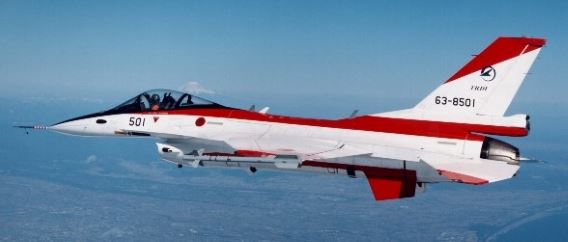
Having flown for the first time on October 7, 1995, the first prototype Mitsubishi F-2A continues to be used for AD&TW test flights from Gifu AB. (Photos: [above] date unknown, JASDF Gifu AB; [below] October 2000)
1997 Grumman U-4 75-3251
 (Photo [date unknown]: JASDF Gifu AB)
(Photo [date unknown]: JASDF Gifu AB)
Seen during its brief time with the AD&TW, the first of the five examples of this version of the Gulfstream IVSP that entered JASDF service.
1998 Boeing E-767 64-3501
 (Photo: JASDF Gifu AB)
(Photo: JASDF Gifu AB)
The first and second aircraft arrived at Hamamatsu on March 25, 1998, from where they underwent a period of testing by an AD&TW team. The remaining pair arrived on February 8, 1999, the type being cleared for operational service on March 24 that year.
2000s
2000 FST-2Kai 59-5107

The seventh (pre-production) T-2 was the second of the two ground-support adaptations built. After testing carried out by Mitsubishi from Komaki, the aircraft was ferried to the APW in late August 1975. Retaining the trainer’s rear cockpit and canopy, the only external difference was the passive warning radar antenna housing atop the tailfin. Seen here at Gifu in October 2000, this aircraft was placed on display at Gifu in February 2017.
2002 Fuji T-7 26-5901 and ’902
 (Photo [date unknown]: JASDF Gifu AB)
(Photo [date unknown]: JASDF Gifu AB)
Then known as the T-3Kai, the first T-7 made its maiden flight on July 9, 2002. The first two aircraft were used for pre-service testing, and other examples of the total of 49 delivered up until September 2008 have occasionally been taken on strength at Gifu. These two aircraft were in line service with the 12th Flying Training Wing at Hofu AB in 2018.
2008 Boeing KC-767 87-3602
 (Photo [date unknown]: JASDF Gifu AB)
(Photo [date unknown]: JASDF Gifu AB)
Delivered in 2008, the initial pair of KC-767s was followed by another aircraft in each of the following two years.
2008 F-15J Eagle 12-8928
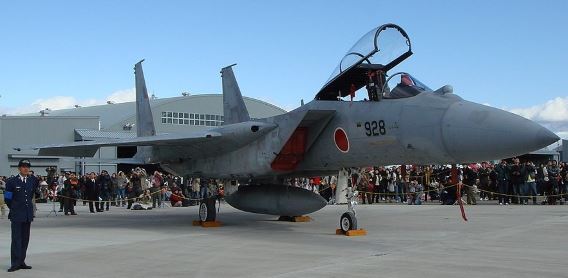 (Photo [Nov. 2008): Hunini via Wikimedia Commons)
(Photo [Nov. 2008): Hunini via Wikimedia Commons)
Initially assigned to squadron service, this F-15J had taken up a residency at the AD&TW by 2008 and, aside from return visits to Komaki for maintenance, has remained in service there to this day. The aircraft’s involvement in the F-15J modernization programme is evidenced by the infrared search and track (IRST) system housing on top of the nose.
2010s
2012 Kawasaki C-2 18-1202
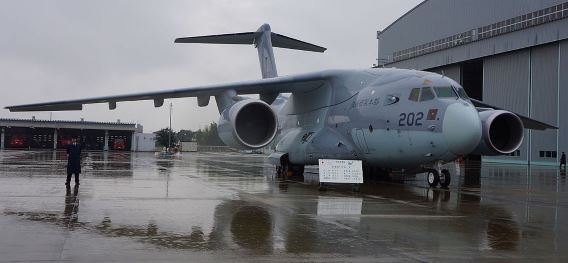 (Photo: Hunini via Wikimedia Commons)
(Photo: Hunini via Wikimedia Commons)
The second prototype C-2 stands in front of Hangar No. 7 at a rain-swept Gifu in October 2012. Having flown for the first time on January 27, 2011, this aircraft was heavily modified for the electronic intelligence (ELINT) role, in which guise it first flew from Gifu on February 8, 2018. As shown here in August 2018 (link), some of the flight test programme is being conducted from Iruma, which will be its eventual home.
 (Above and below) Marking the major milestone in 2014, many of the AD&TW fleet sported the JASDF
(Above and below) Marking the major milestone in 2014, many of the AD&TW fleet sported the JASDF
60th anniversary logo on their fuselages or engine intakes. (Photos [Oct. 2014]: Andy Binks)

Gifu Open Day 2016
 (Photo: JASDF Gifu AB)
(Photo: JASDF Gifu AB)
Alongside the comparative newcomer XC-2 (above), old stagers were much in evidence at the Gifu air show held in October 2016. (The following six photos: Hunini via Wikimedia Commons)
 The C-1 prototype was re-designated the C-1FTB, standing for Flying Test Bed.
The C-1 prototype was re-designated the C-1FTB, standing for Flying Test Bed.
 At the time a 45-year-old veteran, the venerable first F-4EJ deploys its brake parachute after landing.
At the time a 45-year-old veteran, the venerable first F-4EJ deploys its brake parachute after landing.
Like other Gifu-assigned Phantoms, ’301 was never upgraded to F-4EJKai standard.
 A mere 36 years after its arrival from McDonnell-Douglas in 1980, the first F-15J was
A mere 36 years after its arrival from McDonnell-Douglas in 1980, the first F-15J was
also present on the Gifu flight line.
 (Above and below) The Gifu AB open house events provide an opportunity to see other hardware that is
(Above and below) The Gifu AB open house events provide an opportunity to see other hardware that is
or has been undergoing testing. The F-15J above has a sharkmouth-adorned TACOM UAV on its
starboard inboard pylon beneath a Type 90 air-to-air missile (AAM-3). Seen sharing a pylon
with Type 04 (AAM-5) short-range missiles, the UAV below sports a digital pixelated
camouflage scheme; note the SUBARU Corporation logo on the engine intake blank.
(This UAV is now on display next to the F-1 and F-104J at the AD&TW’s Fuchu HQ – see foot of page.)

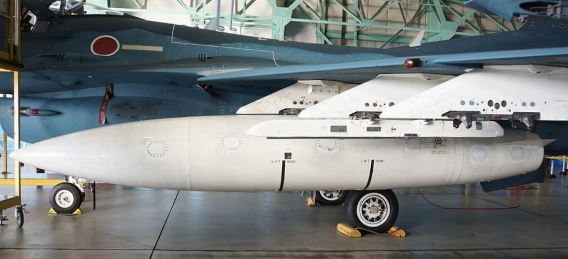 A 2,300-litre (600 U.S. gallon) drop tank fitted to AD&TW F-2A ’514 for test purposes. In contrast, the
A 2,300-litre (600 U.S. gallon) drop tank fitted to AD&TW F-2A ’514 for test purposes. In contrast, the
nearby Gifu-Kakamigahara Air and Space Museum includes an exhibit on the local girls’ high school
that produced wooden 200-litre (53 U.S. gallon) drop tanks for the Hien fighter during World War II.
2017 Mitsubishi X-2 Advanced Technology Demonstrator 51-0001
 (Photo: なごやん via Twitter @N682G)
(Photo: なごやん via Twitter @N682G)
 (Photo [Nov. 2017]: Hunini via Wikimedia Commons)
(Photo [Nov. 2017]: Hunini via Wikimedia Commons)
A Ministry of Defense project, the X-2 landed at Gifu at the end of its first flight from Komaki, on April 22, 2016, and has been stored there since the end of its series of data-gathering flights, which were carried out with an AD&TW T-4 chase plane in attendance. The pitot tube that was mounted on the nose for its flight test programme has been removed. (This aircraft was on display again in November 2018.)
 Now designated the X-2, the then Advanced Technology Demonstrator (ATD-X) was unveiled on
Now designated the X-2, the then Advanced Technology Demonstrator (ATD-X) was unveiled on
May 8, 2014. (Photo: Japan Ministry of Defense/TRDI)
(http://www.mod.go.jp/trdi/news/1407_2.html)
In July 2014, the TRDI website featured photographs of its then engineless experimental Advanced Technology Demonstrator (ATD-X) being towed out of a paint shop at the Mitsubishi Heavy Industries (MHI) Komaki South Plant in Nagoya on May 8 [link]. Taken from above, one photo revealed the relatively small size of the aircraft; although taken into the sun, the other showed the aircraft almost in profile and the line of the wing merging point above the side-mounted air intake.
Timed to coincide with the appearance of the photos on the TRDI site, a behind-the-scenes report on the aircraft was featured in a 30-minute segment aired on Tokyo-based TBS TV’s Japan News Network programme on July 12. Screen grabs soon started to appear on social media [link] and the entire programme was even uploaded to YouTube [link].
The definitive X-2 was presented to members of the media in its Komaki South hangar on January 28, 2016, as recorded on another YouTube video [link]. The video also includes footage of one of the radio-controlled models (see below).
Roughly the size of a Saab JAS39 Gripen and sporting the standard red and white colour scheme favoured for military aircraft prototypes, the aircraft represents the latest phase in a feasibility study programme that was launched in 2007 but dates back to 2000. Originally, what is now the X-2 was given the enigmatic codename Shinshin, the two-kanji combination that has the general meaning of mind or spirit, but this appellation is no longer used.
In addition to the undertaking of research into flight control systems that would enable highly manoeuvrable flight, a more sinister-looking, full-scale radar cross section (RCS) model was tested at a French government facility in the latter half of 2005 and displayed at the Japan Aerospace Exhibition in 2008 after the conclusion of that stage of development. The X-2’s low RCS-optimized fuselage cross section, described in the Japanese aviation press as like that of an abacus bead, arose from that research.
[Above and below] A full-scale model of what was to culminate in the X-2 underwent radar cross-section testing at the French Direction Générale de l’Armement facility near Rennes. These photos appeared in the defence white papers for 2007 and 2008, respectively.
(Photos: Japan Ministry of Defense)
The RCS model was followed by flyable, one-fifth scale models, one of which was revealed in 2006 [link]. From that year, five years of parallel research were conducted into the so-called smart skin, whereby the external fuselage structure is embedded with self-diagnostic microsensors. Manufacture of the ATD-X, now X-2, and a ground test airframe commenced in 2009.
 Also appearing in the Defense of Japan 2008 white paper, this photo shows technicians preparing one of the radio-controlled scale models that were used for high angle of attack testing.
Also appearing in the Defense of Japan 2008 white paper, this photo shows technicians preparing one of the radio-controlled scale models that were used for high angle of attack testing.
(Photo: Japan Ministry of Defense/TRDI)
As its initial name implied, the ATD-X was destined to be used as a test bed for research and systems integration. The aircraft is intended to act as a stepping stone on the way toward the possible production of a scaled-up, next-generation fighter, incorporating what have been dubbed i3 (informed, intelligent, instantaneous) technologies and counter-stealth features. Released by the TRDI, the early examples of digital mockup (DMU) concept designs from 2011 and 2012 resembled the F-22 Raptor and Northrop/McDonnell-Douglas YF-23, respectively. Dubbed 25DMU (from the Japanese calendar year Heisei 25, or 2013), the latest known example incorporates some of the design features of its predecessors.
Following the RCS model, a combination of a model displayed at a TRDI event in 2007 and a 1/10th scale wind-tunnel model displayed at Gifu AB open day in October 2012 (photo below) had already provided heavy hints with regard to the direction the then ATD-X’s configuration was taking, but closer inspection of the photos from May 2014 revealed more details of the definitive version. Salient points included the four-sided horizontal tail surfaces, which had been five-sided in the full-size mockup, and the rounder air intakes. As tends to be the case in the Japanese aircraft industry, the aircraft represents a joint effort, with one prime contractor (MHI) mating major assemblies from other companies; the wings and both the horizontal and vertical tail surfaces were supplied by Fuji Heavy Industries.
 (Photo: Hunini/Wikimedia Commons)
(Photo: Hunini/Wikimedia Commons)
Building on earlier research that was also conducted in the 2000s, the X-2 will be used to investigate axisymmetric engine nozzle thrust vectoring. This will be achieved by three “paddles” mounted around each tail pipe, as seen below in a close-up view of the wind tunnel model. Such devices have previously appeared on the ill-fated Rockwell-MBB X-31 and NASA’s F/A-18-based High-Alpha Research Vehicle. All things considered, the X-2 marks an important step in Japan’s efforts to retain and build on the expertise accumulated in the production of its own fighters.
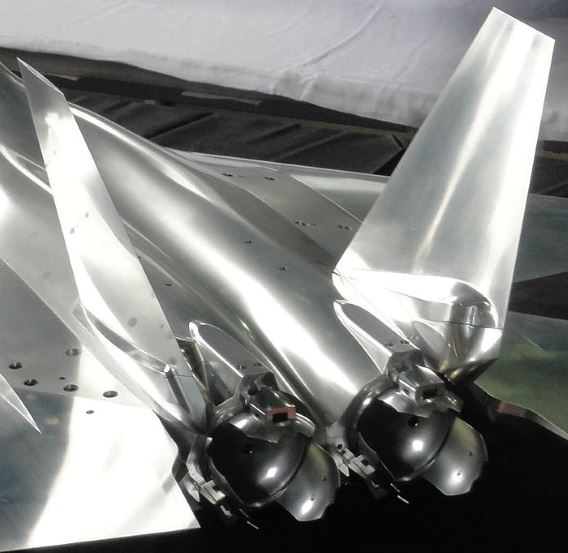 (Photo: Hunini/Wikimedia Commons)
(Photo: Hunini/Wikimedia Commons)
Also worthy of note in those May 2014 photos was the cost-saving use of a canopy from a Kawasaki T-4 (prompting design changes from the T-2 canopy on the full-size mockup) and the undercarriage from a Mitsubishi T-2, although each of the mainwheels sports the T-4’s cluster of three landing lights. For some reason, the area of the standard hinged T-2 noseheel door was masked in some views in 2014; masked areas also appeared on the fuselage sides aft of the cockpit, presumably obscuring intakes.
Not content with working on its first indigenous fighter since the end of World War II, the development of the X-2’s two 11,000lb-thrust IHI XF5-1 turbofan engines, first installed on the aircraft in July 2014, also breaks new ground through the utilization of ceramic composite turbine blades. The XF5-1 has its origins in basic research carried out from 1991. The first of four test engines was delivered to the TRDI in 1998, but a full five-year prototype programme was not scheduled to start until 2015. Reflecting the X-2’s role as a lower-powered, scaled-down test bed, the next-generation fighter, if proceeded with, is planned to be powered by a pair of a small-diameter 33,000lb engines of a type that has been under development since 2010.
On January 7, 2015, The Asahi Shimbun website reported that the first flight of the X-2 stealth demonstrator, which had been planned for that month or at the latest by the end of the fiscal year (March 31), had been postponed to April or later. The reason given was that the device that senses the throttle position was not working normally, and fixing the defect would require some corrections to the software. The report quotes the Japan Ministry of Defense as also saying that it had been decided to add a system that automatically restarts the engine in the event of an in-flight flameout, as installed on the latest U.S. fighters.
The aircraft’s first taxying trial took place at Nagoya on February 11, 2016, as recorded in edited form in this YouTube video (link). After being transported by road to Gifu, the X-2’s first flight took place on April 22; a joint TRDI/JASDF test flight programme was then scheduled to run until around spring 2017.
In a November 2017 interview with Flight International, manager of the Future Fighter Program at the Acquisition, Technology & Logistics Agency (ATLA, formerly the TRDI) Hirofumi Doi said that the X-2 had flown 34 of the originally planned 50 flights; only the first two of which had been conducted by Mitsubishi. The project would be concluded in March 2018, but what was to become of what is essentially a data-gathering aircraft thereafter had yet to be decided.
The results of this, the most significant of no less than 15 programmes looking into specific stealth technologies, would allow assessment of the merits and demerits of Japan going its own way with future fighter acquisition or simply adding to its 42-aircraft order for F-35As.
According to the MTDP, a decision on a go-it-alone fighter programme was originally to be made by fiscal 2018, around 10 years before the oldest of the F-2 fleet would be ready for retirement. In January 2016, the Ministry of Defense was envisaging squadron service from fiscal 2028 onwards. (It was then being estimated that the last F-2 would be withdrawn from service in 2035.)
 A still from a video (link) of two AD&TW Phantoms departing Gifu in November 2018.
A still from a video (link) of two AD&TW Phantoms departing Gifu in November 2018.
(Posted November 2023 on X [formerly Twitter] @rikizomisono)
2020s
 It fell to the Air Development & Test Wing at Gifu AB to bring down the final curtain on Phantom
It fell to the Air Development & Test Wing at Gifu AB to bring down the final curtain on Phantom
operations. January 14, 2021, marked the 50th anniversary of the first flight in St. Louis of
the service’s very first example, which had been given a retro colour scheme and AD&TW
tail markings for the occasion. Naturally, 301 was one of three aircraft that took their
final bows on March 17, 2021. (See Bulletin Board story.)
(Photo [Dec. 14]: hiro@ via Twitter @levo2735)
March 15, 2021. Video footage of F-4EJKai 07-8429 departing on last flight, to Tsuiki, where the aircraft was placed in store (link).
APG / APW / AD&TW Tail Markings
As worn by Air Development & Test Wing aircraft to this day, the marking of what was then the Air Proving Group first appeared in July 1964, having been created by a member of the maintenance team. The design comprised a black, arrowhead-shaped sonic boom shock wave and an orbiting artificial satellite, which were very evocative symbols of the scientific age in the late 50s and 60s. Examples of the F-86F, F-104J and T-1 (undated link) also carried the abbreviation ‘APG’, and in its day ‘APW’, but with the exception of special markings this practice ceased with the advent of the AD&TW.
On occasion in the past, aircraft carried the initials ‘TRDI’ on their tails, to indicate testing being conducted at the behest of the Technical Research and Development Institute arm of the Japan Defense Agency (since 2015 the Acquisition, Technology and Logistics Agency of the Japan Ministry of Defense.)
AD&TW SPECIAL MARKINGS
2005 AD&TW 50th Anniversary T-1B 05-5810
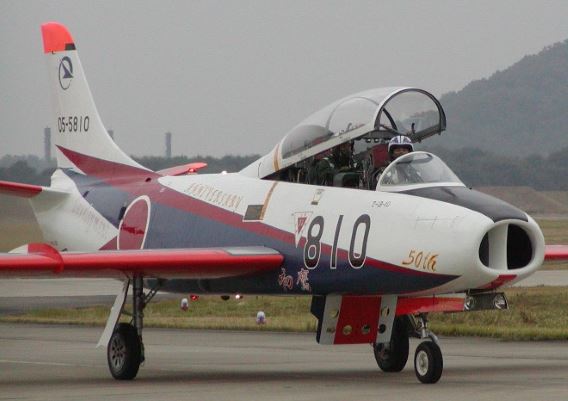 (Photo via Wikimedia Commons)
(Photo via Wikimedia Commons)
The 10th T-1 built in the special markings applied for the AD&TW’s 50th anniversary in 2005. Retired on March 2 the following year—the same day as the AD&TW’s T-2 59-5107 flew for the last time—this aircraft has been on display loan to the nearby Gifu-Kakamigahara Air and Space Museum since January 2007.
November 2017 Gifu City 450th Anniversary T-4 66-5602

Three of the four T-4s that made up the four-aircraft formation photographed in 1986 were present at the Gifu open house event in November 2017. One featured a tail marking (below) featuring the logo for プロジェクト(Project) GIFU CITY, a tourism promotion campaign commemorating the city of Gifu’s 450th anniversary. In 1567, the famous local warlord Nobunaga Oda (1534–1582) changed the name of Inoguchi to Gifu*, elevating the village to town status in the process. The 信長公 means Lord Nobunaga, and the ‘0’ in よんごーまる (‘450’) contains the cross section of a gourd that formed a mon (crest) of the Oda clan. (Photos: Hunini via Wikimedia Commons)
* As an historical aside, the “gi” in Gifu was taken from Qishan, the mountain in China where Wen Wang (1112–1050 BC) set out to establish the Zhou Dynasty, laying the foundations for 800 years of peace. The “fu” refers to Qufu, the birthplace of the revered Chinese philosopher Confucius (551–479 BC). The name now shared by a city and prefecture thus stems from Oda’s desire to make his region a peaceful place of learning, which the AD&TW at least in part maintains.

November 2018 Anime TV Series Tie-in F-15J 12-8928 / 32-8942; F-15DJ 12-8078
 (Photo: JASDF Gifu AB)
(Photo: JASDF Gifu AB)
At the Gifu base event in November 2018, at least three aircraft were decorated with blue “eyes” on their noses. These are a reference to an anime television series called Dragon Pilot: Hisone and Masotan, which is set at Gifu AB. One of the aircraft, on static display in a hangar, had its real serial (12-8928) changed to that of an aircraft in the anime, ’02-8999’.
November 2019 Test Pilots’ School 50th Anniversary T-4 66-5603
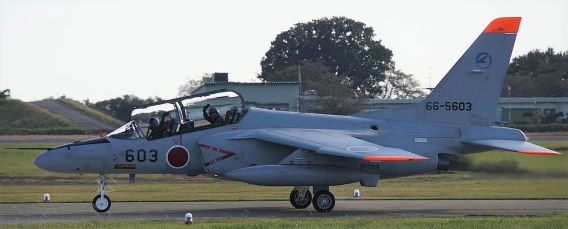 Seen above in standard scheme in October 2016, the third T-4 was painted in a scheme that harked back
Seen above in standard scheme in October 2016, the third T-4 was painted in a scheme that harked back
to that worn in 1986 to mark five decades of the Test Pilots’ School’s existence.
(Photos: [above] Hunini via Wikimedia Commons; [below] S.K 2 [@suzakentothesky])

 (Photo [Oct. 2016]: Hunini via Wikimedia Commons)
(Photo [Oct. 2016]: Hunini via Wikimedia Commons)
Indigenous UAV Programmes (TACOM/UARS)
For such a technologically advanced nation, Japan appears a comparative laggard in terms of the development of an indigenous unmanned aerial vehicle (UAV) reconnaissance system. Although Japanese industry began producing target drones in the 1970s and developed helicopter-based systems for the JGSDF from the 1990s, this accumulated expertise has not been utilized toward, for example, the full-scale development of a sophisticated medium-altitude, long-endurance (MALE) system.
In 1995, however, a team from prime contractor Fuji Heavy Industries (FHI) commenced TRDI-authorized project development work on TACOM, from tayoto kogata mujinki (multirole, small UAV). Essentially a feasibility study for an infrared sensor-equipped, air-launched system, the programme focused on such areas as an autonomous target tracking system. The design included a parachute and flotation bags to enable the vehicle to be retrieved from the sea at the end of a mission.
In the summer of 1998, the prototype F-4EJ Phantom, which was then assigned to the AD&TW, was photographed with a TACOM mounted on each of its inboard underwing weapons stations. The aircraft acted as “mother” ship on a total of 22 missions. Having achieved the first of five fully autonomous flights on May 7, 1999, the flight test programme of this initial design was concluded in 2001.
As shown in the photo above, the third of the six TACOMs built was displayed on a trolley at the Yokohama Pacifico Exhibition Centre during Japan Aerospace 2004. A nearby signboard gave its dimensions (length 4.7 metres, span 2.5 metres) and weight (620kg [at launch]). Note the dorsal air intake for the Teledyne Model 382-10J turbofan and the foldable wingtips, which were extended in flight and enabled the vehicle to fit between the F-4EJ’s centreline and wing-mounted drop tanks.
Funded between fiscal 2004 and fiscal 2011 as the Unmanned Aerial Research System (UARS), the “Improved TACOM” design featured the addition of an undercarriage. Target acquisition and tracking is by means of an infrared sensor mounted in a multifaceted, glazed ventral housing. A sign at a briefing given by the TRDI in 2007 gave the length and height of this definitive version as 5.2 metres and 1.6 metres, respectively, as a well as a weight of approximately 700kg.
The culmination of the initial flight test programme came on December 15, 2009. On that day, a UARS vehicle was successfully launched from an AD&TW F-15J and brought in for its first autonomous landing at the JASDF air base on the island of Iwo Jima. (A photo of the vehicle and video of that first landing can be found on the TRDI website [link].)
Although a prototype was reportedly lost at sea after launch from an F-2 in 2010, it is believed that two vehicles remain. A concept diagram and thumbnail images still appear under Test Records if you scroll down on this page of the TRDI website [link], and the UARS still occasionally appears in the Japanese aviation media. Taken in October 2013 and published in the January 2014 issue of Koku Fan, one photo shows a red-and-white example mounted on an AD&TW F-15J (again the first aircraft delivered to Japan). The vehicle appeared to be equipped with cameras and bore seven mission markings on the side of its fuselage. A fine study of another vehicle, painted in low-visibility grey, appears here [link].
The March 2016 issue of JWings magazine carries a photo of an AD&TW F-15J carrying TACOM 1001 aloft in December 2015. One of two TACOMs on display at the Gifu open house in October 2015—both had been adorned with the unit’s 60th anniversary tail markings and temporary shark’s mouth insignia—1001 had in the interim had two more test flight score markings added for a total of seven.
 After its withdrawal from use, one of the TACOMs was placed on display at Fuchu AB, Tokyo.
After its withdrawal from use, one of the TACOMs was placed on display at Fuchu AB, Tokyo.
(Photo [posted Aug. 2022]: JASDF Fuchu AB via Twitter @FuchuJasdf)
Please note that this and the three main pages devoted to JASDF squadron histories
are constantly being updated and improved.


